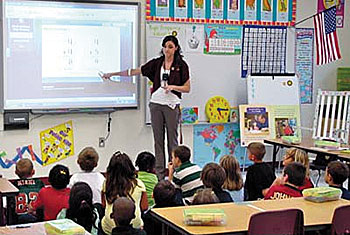More Teacher Time with each Student

A more complete knowledge of each student’s strengths and weakness can assist the teacher in building an academic plan for all students. This process is not new. Teachers have always tried to get to know students better, uncover what their strengths and weaknesses are and then build on that. Unfortunately, as class sizes have increased, that process has proven to be more challenging. A reduced student-to-teacher ratio allows good teachers to do what they do best; to learn students’ needs and to teach.
More Student Participation
A second benefit that is often overlooked is that reduced class size challenges students in subjects they may not be as comfortable with. As in any group, the stronger students are more prone to speak up when a question is poised to the class.
Especially in the primary grades where students are excited to show the teacher what they have learned, a stronger student is more apt to raise their hand. In larger classes, a student who is not as strong in a subject will find it easier to hide from a difficult question. Thus, the stronger students will continue to be challenged while other students will not be progressing academically and are left behind.
Learning to be a Better Student
As one starts to look down the road reduced class size continues to provide many benefits even after the early years of one’s education.
A study completed several years ago found that students who had benefitted from reduced class size in their early educational careers were up to one year ahead of their peers academically by 8th grade. The study habits, engagement and lack of absenteeism become “rules of the road” for these students at an early age and they continue to benefit from it for years to come. These students also benefit from increased high school graduation rates. This is especially true for minority students. Once good study habits are formed, students from every walk of life are more apt to stay the course even as academics become more challenging. The foundation for these students was placed by teachers who had more time to spend with them.
Learning to be a Better Person
Finally, reduced class size allows teachers to more effectively address behavioral issues sooner. As a Trustee, I am surprised to see the list of children who have discipline issues at an early age. We are seeing more children at younger ages facing discipline issues at school than in years past. My hunch was backed up by a 30-year veteran of the District who said she now faces more challenges in the classroom from behavior issues than ever before. As she explained it, at least once a day a student disrupts the entire class with a behavior problem. Not only is this troubling for the student who has the discipline issue but it also is a problem for the other students in the classroom who have lost valuable class time due to one student’s misbehavior. Class size reduction goes a long way in limiting these incidents by giving a teacher more time to work directly with a troubled student and get them the help they need before the problem escalates.
State Priorities are Changing
With study after study highlighting the benefits of reduced class size, I am very encouraged that the state is providing money to roll back student-to-teacher ratios over the next several years. Though the money will come slowly – some estimates are that it will take up to 8 years to see the money necessary to reduce class sizes for all grades – we have turned an important corner in improving education both locally and at the statewide level. As part of these efforts, the District was able to reduce class size for 1st graders for the first time in several years. I realize it is not enough and that we need to do more.
Reducing class sizes is very important to me because of my three children who are attending PVUSD schools. I see first hand what the affect a smaller class size has for one and not having it does for the other, and the effect it has on their education. As a parent, I want each of my sons to have the best education possible. By reducing class size, I know we will be doing just that.